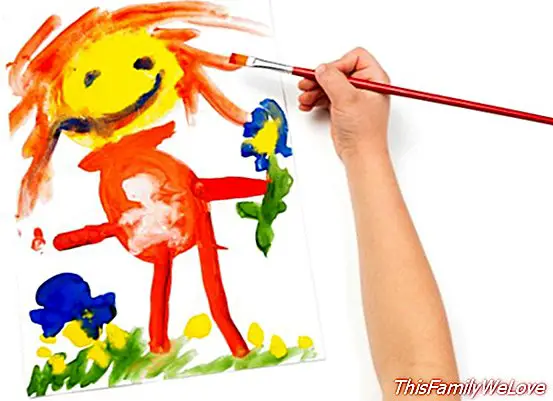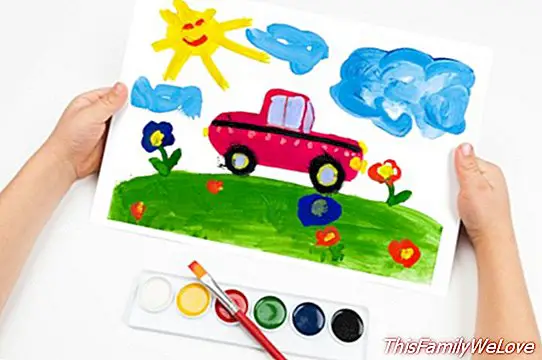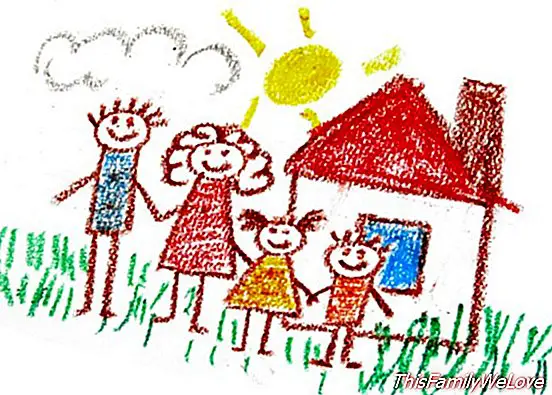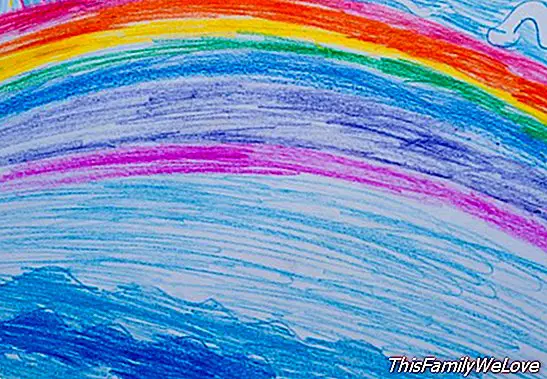6 keys to interpret children's drawings
Through the drawings of children we can glimpse some features of his personality or emotional situations that go through at that precise moment, always bearing in mind that they are not definitive and that the interpretation of children's drawings can not be done in an isolated way, but as part of a set more extensive data.
We must bear in mind that the data we obtain through children's drawings helps us to discover the existence of problems, but they do not give us the clues about the content of them. For this reason, a lot of prudence is advised in the observation of these and before the doubt, if in addition to the drawings there is another symptomatology, always go to a professional.
6 keys for the interpretation of children's drawings
Each child is different even though they are in the same evolutionary stage as the rest: they have their own experiences, a specific environment, a specific degree of maturity, etc. For this reason, the reading of the drawings can not be done outside of a series of important aspects that are all those related to the child's life. To interpret them, several aspects can be taken into account.
1. The size of the children's drawing
Taking into account the folio, if we split it into three we will obtain the data of whether it is large or small, according to the parts that occupy the paper.
- Children who "occupy" or use very little paper They are often insecure, with feelings of self-dissatisfaction. In general, they respond in a self-controlled manner to environmental pressures.
The large drawings (more than two thirds of the paper) correspond to vain children, with enough imagination, who respond in an aggressive and / or expansive to environmental pressures.
- The reference figure usually appears first; however, it can be another character when he appears in it more details and care in his drawing or with a size singularly larger than the other characters.
- When drawing a much smaller brother and with less detail than the others, may indicate devaluation.
- A significant detail if it appears prominently are the ears: When the child gives them a lot of importance, drawing them in detail or large, it would indicate that he is worried about what others think or talk about him.
- When the size of the drawing is small in general, it does not exceed a quarter of the available page, it can mean either that it presents feelings of inadequacy, or an insufficient self-image, with feelings of inferiority or a certain withdrawal.
2. The placement of the characters in the child's drawing
The classification is made in relation to the vertical axis of the paper.

- Children who "place their characters" on the top are those who have fantasy, spirituality, is the "world of ideas", which set unattainable goals or feel that they make a great effort.
- Those who place them in the lower left part of the folio they are children who rely on reality, are more concrete, seek the firm and solid. At the same time, it is more typical of children with a tendency to introversion and impulsive behavior. It may also reflect a propensity to look back on the events of life.

- Eye with those whose representations seem to end up on the table Because the paper has been scarce from the bottom, they may have depressive feelings.
- Those who occupy the central part they are the most affective children, who use the "paper heart zone"; It also implies security.
- On the right side indicates extraversion and that looks to the future.
- The proximity of some characters to others It may indicate the perception of a certain special relationship between these characters in the child's judgment. For example: if he draws a brother between the two parents, it may be that he perceives a certain favoritism towards him. If he had drawn himself between his two parents, what he would indicate is that he seeks protection and support from them.
Sometimes, although not strikingly, in the drawings of the children two strata or levels of situation are observed in the characters of the family: the existence of strata is usually due to the existence of communication problems in the family. If the characters are widely separated from each other, it denotes that they perceive a lack of communication between them. If each character occupies a corner of the paper we understand that there is incommunication; the family members do not share anything, nor do they observe any kind of interaction or dialogue.
3. The order of appearance of the characters in the child's drawing
- The child draws first the person he considers most important. In this way, the character that the child draws in the first place indicates that he is the one he most admires, envies or fears.
- When you draw yourself, depending on the age, may indicate an excessive degree of egocentricity, which must be overcome in the early stages of childhood.
- Regarding the character drawn last It is significant when it comes to oneself, because it implies a high degree of devaluation towards oneself. Whether it is your mother or your father indicates devaluation towards him or her.
4. Removal of some element of the family

- Suppressing someone is the highest degree of possible devaluation towards that person. When the child suppresses a member of his family, he indicates that he has a conflict with that character, which he "avoids" by not reflecting it in his drawing.
- A similar conclusion can be reached when you suppress your face, for example, drawing it from the back, shading it or covering it in some way.
- Another element whose elimination is important is the hands, that in the drawings of children represent the organ of affection. Therefore, if he suppresses them, he states that he finds difficulties in his relationship with family and environment.
5. Pressure exerted and type of stroke in children's drawings

- When the pressure exerted by the stroke is strong indicates tension that may be related to some or all of the characters in the drawing, depending on where it appears. It is understood that there is pressure when the stroke would not disappear completely, or if the trace is marked on a page below the one in which it is drawn.
- If the stroke is rather short, It is typical of impulsive people.
- If on the other hand it is a long stroke, respond to children with self-control of their behavior.
6. Borraduras in the drawings of the children
- Erases in children They are usually an indicator of emotional conflicts.
- Erasing is also typical of boys and girls with self-dissatisfaction and insecurity or a certain desire for perfectionism.
- If intense shading is observed, it would indicate the existence of some type of emotional conflict (anguish, anxiety, etc.).
- Continuous erasures they are a call to examine our way of acting as educators, we do not want perfect children but happy and with an optimal development of their personality. Behind the frequent use of rubber there are indications of excessive perfectionism on the part of the child or a great insecurity. These factors are closely related to the type of parents (punitive parents-unsafe children).
Jorge Bodes
Advisor: Macu Lluch Baixauli. Director of the Comprehensive Educational Counseling Center
You may also like:
- Children's drawing, a tool for family communication
- The evolution of children's drawing
- Creativity in the development of children
- Ideas to enhance creativity at home
- The fantasy and imagination of children




